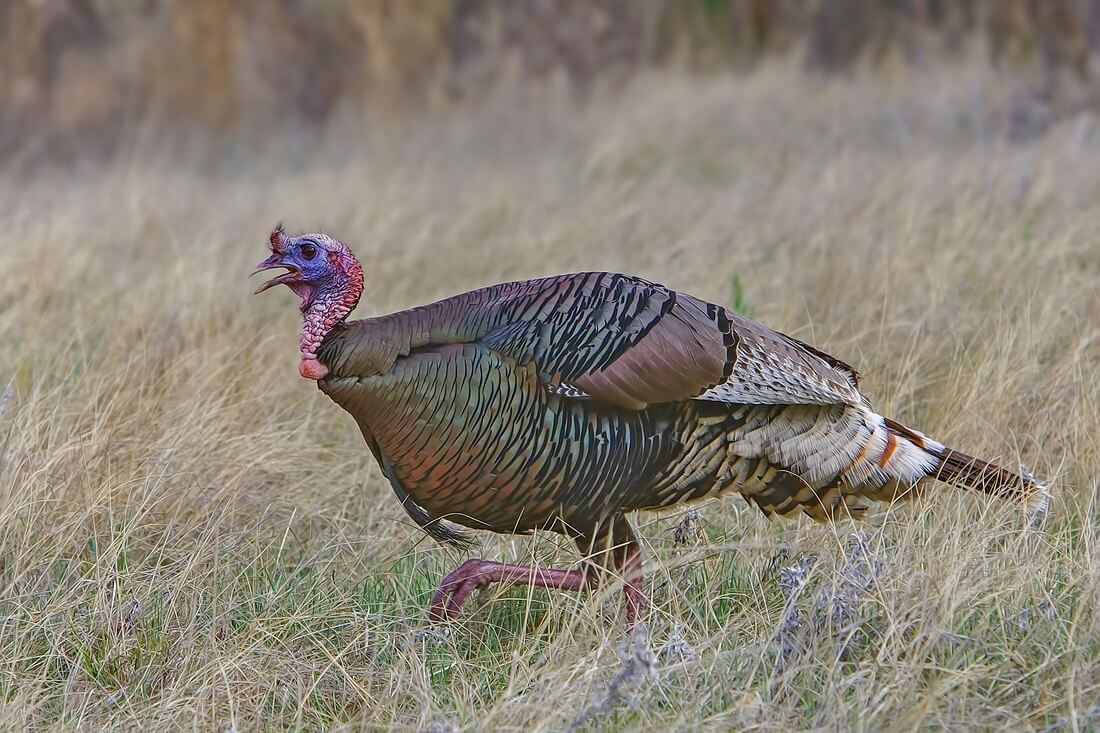Order in the Roost
by Jim Giese
Broadcast 10.29 and 11.1.2019

Wild Turkey, photo by Alan D. Wilson, naturespicsonline.com
Listen:
Each day the turkeys march twice across my front lawn, once each morning and again in the evening. When I first arrived last fall to my rental property in the Bitterroot Valley it was impossible to miss the turkeys. A flock of approximately thirty was feeding in the south pasture; many of the birds were varying sizes of the year’s hatch. The presence of a moving truck and vehicles didn’t seem to bother the birds. Neither did my two dogs.
As the months passed and fall turned to winter, and winter to spring, I got to know the birds and their daily routines. Just to the south of my home, in a steep hillside peppered with ponderosa pines, is the turkeys’ roost. Without fail and regardless of the season, the turkeys would be in the roost before dark. In the mornings, the chorus of gobbles would announce the bird’s drawn-out exodus from the pines.
On a cool yet comfortable late winter evening in March, I sat on top of the hill above the roost, camera in hand, with hopes of capturing the ungainly flight of the birds. I positioned myself about fifty yards from where the birds launch themselves, in what I can only describe as a leap of faith. My presence did not seem to bother the routine as they strutted by and then lined up at the edge of the steep hill before they took flight – sometimes in groups of two or three, but usually as individuals.
Once in the trees a dance began. The turkeys would leap from branch to branch and sometimes switch trees in trying to get higher and higher—or so I thought. I began to wonder if the social hierarchy, so well-established for turkeys while on the ground, carries to the roost and what advantage, if any, height would provide. Was it possible that the ideal place in a tree could be the middle, high enough from land-based predators, yet low enough from any threats from the night skies?
For the next few weeks I began watching the birds as they entered the roost, trying to pick out distinguishing marks that could help me in trying to determine if the same birds were picking the same spots each evening. Not surprisingly, frustration soon set in. Any attempt to keep track of forty to fifty birds by tail feather patterns (especially difficult at dusk) or missing feathers (which change too often) proved beyond my skill set. My attempt at using pictures just added to my frustration. Any passing thought I had of using mark-recapture techniques by way of a paintball gun were quickly balances by the morality of injuring a bird.
Literature searches, although interesting, turned up nothing relating the position of a bird within a specific tree to a hierarchical system. I did discover that the roost to the south of my house fits perfectly with what is expected from the literature. Mature ponderosa pines: check. East-facing slope: check. Easy access to roost sites: check. So I turned to a friend who studied wild turkeys in Wisconsin as part of his graduate work. He was not aware of any research that has attempted to uncover roosting social order. His guess was that there is some sort of hierarchical structure in the roost with “dominant” birds having the first dibs on better or higher branches—but he admits that this is just a gut feeling. He recommended a 1971 paper in Scientific American titled “The Social Order of Turkeys” that’s apparently the standard citation whenever folks mention social order in turkeys, but it only covers the time when birds are on the ground.
So I am left without a definitive answer to my nagging question. For now I don’t understand this piece of the story these turkeys have to tell. I am okay with that, and for now I will remain content in knowing there is still a story that is left untold.
Every week since 1991, Field Notes has inquired about Montana’s natural history. Field Notes are written by naturalists, students, and listeners about the puzzle-tree bark, eagle talons, woolly aphids, and giant puffballs of Western, Central and Southwestern Montana and aired weekly on Montana Public Radio.
Click here to read and listen to more Field Notes. Field Notes is available as a podcast! Subscribe on iTunes, Google Play, or wherever you listen to podcasts.
Interested in writing a Field Note? Contact Allison De Jong, Field Notes editor, at adejong [at] montananaturalist [dot] org or 406.327.0405.
Want to learn more about our programs as well as fun natural history facts and seasonal phenology? Sign up for our e-newsletter! You can also become a member and get discounts on our programs as well as free reciprocal admission to 300+ science centers in North America!












